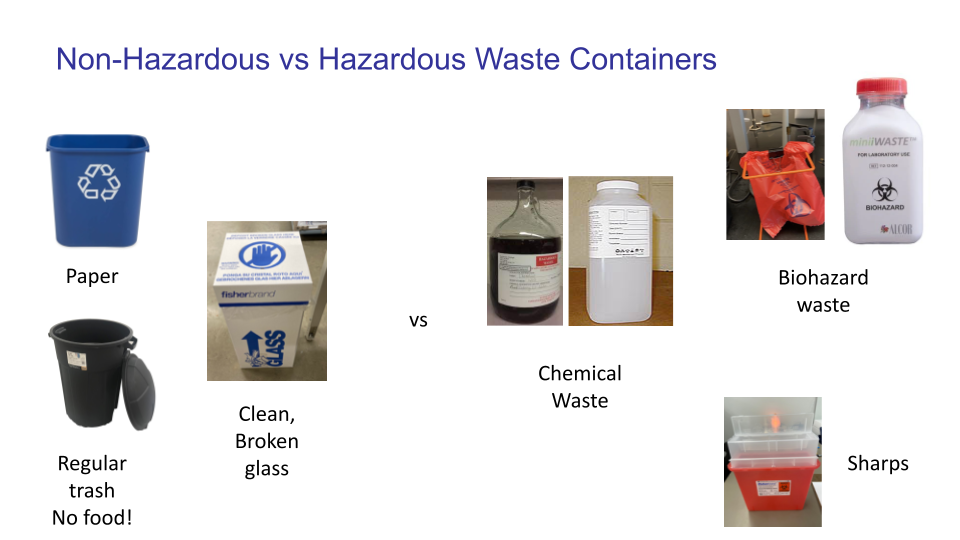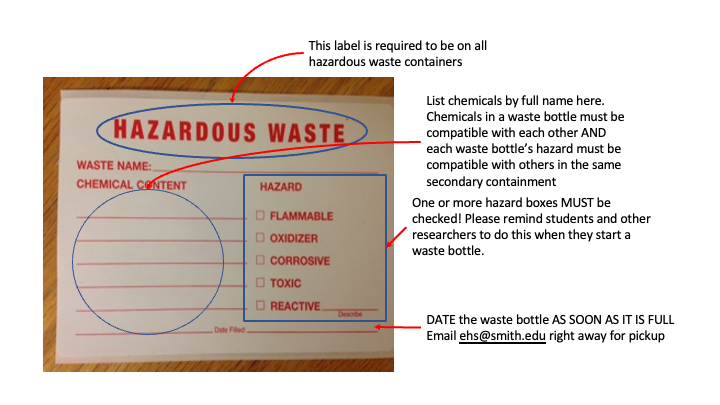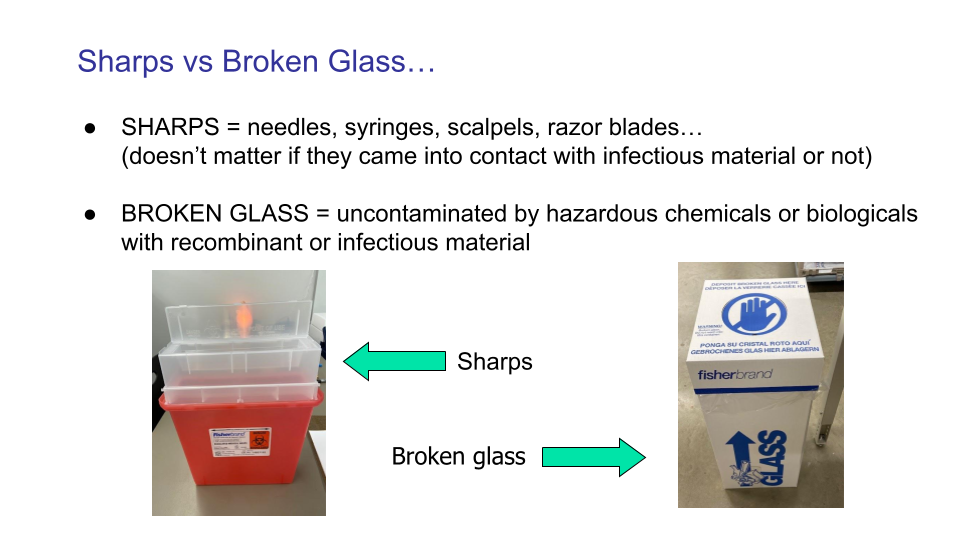Whether you are conducting your own experiment or are a part of a class, you are responsible for the appropriate disposal of all the chemicals you handle. Consult your supervisor regarding your hazardous waste. You may be allowed to dispose of non hazardous materials (ex. Buffers pH neutral) in drain or trash…
BUT in general, for hazardous waste…
- No drain disposal
- No disposal in trash bins
- No evaporating waste in fume hoods
Make sure you are wearing, at a minimum, safety glasses, a lab coat, and gloves. when handling waste containers. For handling acids and bases (even ’empty bottles’) safety goggles are required.
Waste containers

Handling hazardous waste working as a regular student in a class
You will be provided with waste containers already set up and labeled that you can use. Make sure you put each chemical in its proper waste container. If the label does not have your chemical listed, consult with your TA/Instructor before putting your chemical in. You want to make sure all the chemicals disposed in the same container are chemically compatible. To learn about chemical compatibility consult this resource. Waste bottles must be kept closed when not in immediate use.
When the container is about 80% full, put it aside and declare it “full”.
Handling hazardous waste working as a TA, RA, faculty, or staff
You will need to set up and label a/several waste containers. The Science Center stockrooms have empty waste containers and new waste container labels available (in blue or yellow marked cabinets outside stockrooms) in a variety of sizes .
Each waste container must have a hazardous waste label affixed. The following information should be placed in the label :
- The name of the course, experiment, or room number where the waste will be produced.
- Chemical names (written out, no formulas or chemical shorthand) of every chemical present. Ensure they are all compatible! To learn about chemical compatibility consult this resource and ask your supervisor.
- The appropriate hazard box checked. To learn about hazard classes consult this resource and ask your supervisor.

- When the container is about 80% full, put it aside and declare it “full”.
- Date and pH all full bottles. Put a SMALL ‘X’ in the upper corner of the label – please don’t overwrite the ‘Hazardous Waste‘ lettering or the contents of the bottle – to mark it as ready for pick up.
- Follow up with an email to: ehs(at)smith.edu to request hazwaste pickup. Please include in your email your building and lab room #; if it is a large number of containers or if you need a pickup right away, please state that in the email.
How to dispose of an empty bottle that once had a chemical in it?
- Bottles with residual acute toxins (via any route-dermal/inhalation/oral), water-reactive materials, oxidizers, or pyrophorics should not be recycled and should be handled based on a discussion with the faculty member and myself. (By water-reactive is meant a chemical like sodium, not a material that simply deteriorates or is hygroscopic). Check the bottle’s label to see if it is acutely toxic, water-reactive, an oxidizer or pyrophoric. Email mrakas(at)smith.edu if you are not sure.
- Bottles have to have only droplets or particles of chemicals left in them–if you can pour something out, it’s NOT empty. Empty the bottle into the appropriate waste container before proceeding further.
- Remove the barcode adhesive tag located to the right of the label (typically) and put it on a piece of paper (it can go into my mailbox or the Stockroom mailbox).
- Bottles with ‘normal’ chemicals–standard solvents, acids, bases, and the like–should first have the cap removed, then draw a line through the chemical name JUST ONCE, and the words “EMPTY/WATER RINSED” should be written on the label. Finally, thoroughly rinse with water three times (that doesn’t mean you have to fill it up all the way three times, just enough to slosh around the entire bottle, about 1/8 of its volume). Triple rinse the cap and throw it in the trash (it does not recycle). MAKE SURE ALL BOTTLES HAVE BEEN WATER RINSED AND ARE NOT CAPPED.
- OXIDIZERS should be filled with water to the top of the bottle and triply rinsed, same with caps for oxidizer bottles. We don’t want to have a fire.
- Once rinsed, bottles may be put in the recycling bin.
How do I dispose of Biohazard/Biomedical waste?
- Your adviser will tell you what is bio-waste
- All Biohazard waste MUST go into red “Biohazard” bags (solids) or have a Biohazard sticker on the container. Each lab buys its own bags.
- Biohazard Bags/Containers MUST be closed when not in use
- Liquid and solid waste. Typically these are autoclaved and then discharged
- Tom Spooner manages the autoclave program and requires first-time users to be trained by him. Your supervisor can help you arrange a training session with Tom.
How do I dispose of broken glass or sharps?
How do I dispose of batteries?
If they are alkaline they can go in the regular trash. If they are not they can be placed in the proper recycling bins located on the second floor of Ford Hall outside room 226. Make sure the anode and cathode are both taped up. If they are large they must be submitted to the EH&S officer as chemical waste.

